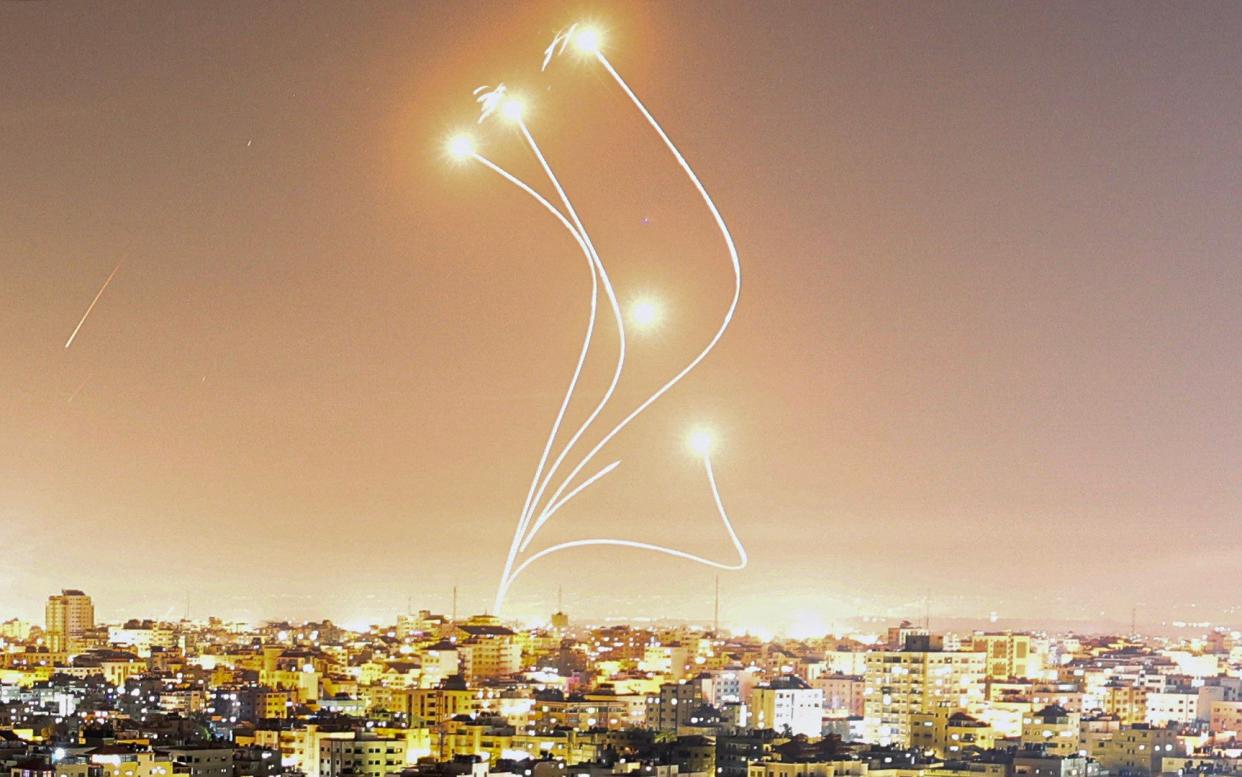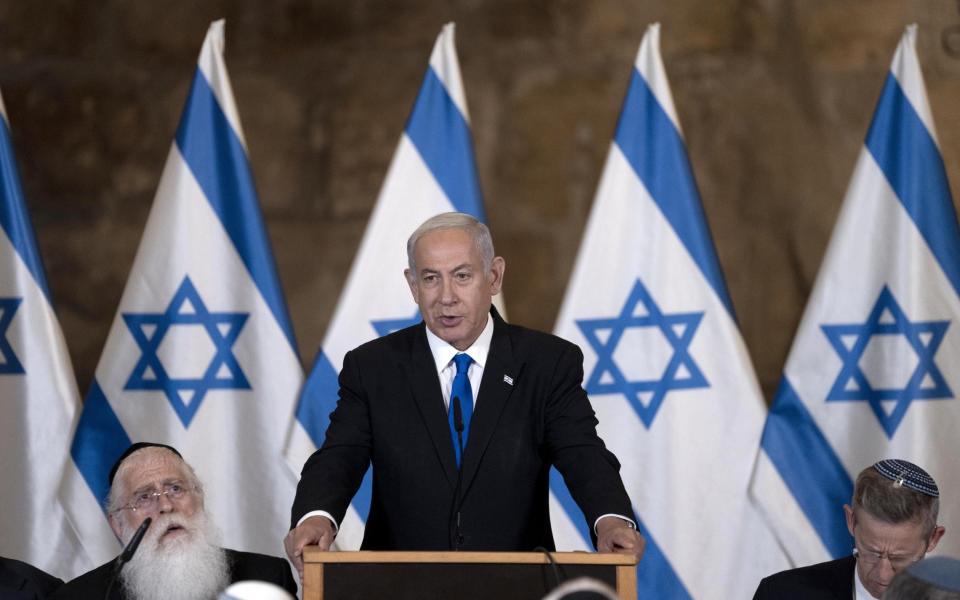Inside Israel’s plan to defend itself from attack by Iran

Elhanan Kaplan, a farmer on Israel’s northern border with Lebanon, rushed to his bomb shelter as soon as he heard that the rockets were coming.
“We heard a boom, a big boom,” said the 72-year-old resident of Moshav Betzet. “It sounded close.”
Before long he was back outside, watching his chicken coop burn down: a rocket launched from just a few miles away in southern Lebanon had crashed through the roof and exploded, leaving the metal shelter wreathed in flames.
But farmers like Mr Kaplan and his son are lucky. Their neighbourhood is protected by the Iron Dome – the sophisticated and eye-wateringly expensive air defence system that uses swirling interceptor missiles to blast incoming rockets out of the sky.
Thanks to Israel’s defences most of the other 33 rockets launched on the afternoon of April 6 were intercepted, resulting in only minor injuries and damage to buildings. By chance, the coop was empty at the time.
Israel blamed Hamas forces in Lebanon for the attack, which came in response to footage of Israeli police beating Palestinian worshippers with batons and rifle butts inside Jerusalem’s al-Aqsa mosque during Ramadan.
It was the single biggest rocket barrage launched from Lebanon in nearly two decades, evoking harsh memories of the 2006 Lebanon war and underlining a grim new reality: many in Israel suspect a fresh onslaught on an unprecedented scale could be just weeks away.
Amid a surge in violence in the Holy Land, Israeli officials are preparing for a “multi-front war” which could see hundreds, if not thousands, of missiles and drones launched per day from Gaza, Lebanon, Syria and potentially even Iraq, where a Tehran-backed militant group has threatened to join the fray.
Northern Israel could bear most of the brunt of that conflict, as Palestinian militants and the Iranian proxy group Hizbollah in southern Lebanon have an estimated 150,000 rockets pointed at Israel.
But there are also concerns that Iran, which has proxies in all four areas, is making plans for a coordinated missile assault on the Jewish state, possibly to deter or retaliate against an Israeli attack on its nuclear programme.
Israeli air defences braced for all-out assault led by Iran
At his Tel Aviv headquarters, Lt Col Richard Hecht is poring over a map of Israel’s regional foes showing the broad extent of their firepower and rocket range. Map markers suggest that long-range rockets fired from Lebanon or Gaza could hit Jerusalem and Tel Aviv, and might even travel as far as the Israeli tourist resort of Eilat in the south.
“When we look at a full-scale campaign it’ll be the little event in Gaza and then the big event in the North [of Israel] which will be predominantly Iran,” said the spokesman for the Israel Defence Forces (IDF), referring to Tehran-backed militant groups.
Previous attacks on Israel have followed a well-established pattern, with Hamas in the Gaza Strip firing rockets at Israeli cities, which in turn prompts several rounds of airstrikes by Israel before an eventual ceasefire.
While much of the violence in Israel and the West Bank this year has been ground-based, air defence is increasingly a priority as threats could come from unexpected places.
At the height of the Ramadan tensions in April, the Iran-backed Iraqi militia group al-Nujaba released an unusual video threatening drone strikes on Israel, stressing that “our souls are deeply connected to Jerusalem”. Iran-backed forces in Syria also launched their own rocket assault in April on the Israeli-occupied Golan Heights, in response to videos of the police raids.

For the Israeli army, the nightmare scenario would be an Iran-led air assault from all sides, with the goal of piercing Israel’s formidable air defences.
“The big issue here is because they probably can’t beat us on the conventional battlefield, their efforts will be in quantity of rockets, projectiles and the story will be precision,” said Lt Col Hecht. “As we’re advancing our air defence, our enemies are also part of that race, they’re investing in precision. They’re investing a lot in being able to saturate our system.”
Then there is the question of Iranian-made drones, a threat that increasingly concerns Israel as Tehran continues to ship them to Russian forces for use on Ukrainian cities. In return, Moscow is providing Tehran with advanced SU-35 fighter planes that could be used to attack Israel.
“For us strategically, the fact that these capabilities are also going up north towards Russia, not only towards Lebanon [and] Syria, it shows, from our narrative, it’s not only a problem for Israel, it’s also a problem for the Western powers fighting against the Russians in Ukraine,” said the IDF.
As to whether attempts to overwhelm Israeli air defence might succeed, his cautious response was that “it depends on the scenario”.
Israeli security experts said there was high confidence about fending off such attacks, especially as the army has experimented with new air defence techniques, including lasers.
But Yehoshua Kalisky, a senior researcher at Israel’s Institute for National Security Studies, stressed that “even one rocket can be very dangerous”.
“We are surrounded... and they are well equipped, with very accurate long and medium-range rockets and missiles,” he said. “It’s a real threat. And the quantity is huge.”
Holy Land gripped by worst violence in decades
Only five months into 2023, the year is already proving to be one of the bloodiest in recent memory for the Israeli-Palestinian conflict. Israeli forces have killed more than 156 Palestinians, including 26 children, while on the Israeli side 19 people have been killed.
But several new elements – and some unwelcome echoes of the intifadas of the 1980s and 2000s – are ramping up the risk of an even bigger, regional confrontation.
The rise of the most Right-wing government in Israeli history, which includes a convicted supporter of Jewish terrorism in the role of security minister, has stoked tensions between Israel and its neighbours.

There is also concern that Benjamin Netanyahu’s divisive plans to overhaul the legal system, which has triggered unprecedented mass protests and nationwide strikes, makes the country look weak and exposed at a time when Iran is watching closely and building up its proxies’ arsenals.
Earlier this month, Ebrahim Raisi, the president of Iran, explicitly cited such unrest as evidence that the “Zionist entity is heading toward its demise”. Then, on Thursday, the Iranian regime unveiled a new ballistic missile with a range of 2,000km (1,250 miles) dubbed the Kheibar.
The name was a reference to a famous battle in which the Prophet Mohammed killed thousands of Jews – and the missile itself was shown off alongside a replica of al-Aqsa mosque in Jerusalem.
Jerusalem violence or a strike on nuclear sites could light the fuse
Soon after the April 6 rocket attack, defence minister Yoav Gallant turned up to an Israeli reporters’ briefing with a gloomy assessment.
“This is the end of the era of limited conflicts. We are facing a new security era in which there may be a real threat to all arenas at the same time,” he said. “We operated for years under the assumption that limited conflicts could be managed, but that is a phenomenon that is disappearing.”
Mr Gallant was referring to Iran and its proxy groups in the region, and his comments are broadly reflective of an Israeli narrative in which Tehran directs or influences nearly all security crises in the Jewish state. But experts and sources familiar with Israel’s security establishment are more circumspect about the risk of all-out war, and the extent to which Iran would be the primary aggressor.
Hugh Lovatt, a Middle East analyst at the European Council on Foreign Relations, stressed that some groups considered proxies of Iran, notably Hamas, were more independent of the regime than is often claimed.
“It would be wrong to view these groups as purely subservient to Iranian interests,” he said. “Jerusalem remains very much of importance in terms of symbolism for these groups, perhaps Gaza and the fate of Islamic Jihad less so. Likewise, Hamas has its own internal calculations … it’s very complicated and nuanced.”
An Israeli security source said the April 6 attack may not have happened at all had police not been filmed beating worshippers. Looming over the entire crisis is the fate of Iran’s nuclear programme, which may yet end up being the primary trigger for a massive regional conflict, rather than localised violence in Jerusalem.
Israel is believed to be closer than ever to launching decisive military action on Tehran’s nuclear programme, which it regards as an existential threat. Fears in Tehran of the programme being destroyed by Israeli forces could partly explain the mobilisation of proxy forces around Israel as a form of deterrence.
“Iran as a sponsor for a lot of these groups has an interest in building the local and regional infrastructure to respond to any Israeli attack against its nuclear programme,” said Mr Lovatt.
Hopes rest on laser defences – if they arrive in time
Back in Betzet, where farmers trundle down dirt tracks in buggies and the air is pierced only by scattered birdsong, the prospect of all-out war seems distant indeed.
But look closer and the signs of an imminent conflict are all there: fortified homes, scattered air defence batteries and of course guns, strapped on holsters or stashed in homes.
“We live in the best and most beautiful area in Israel,” said Mr Kaplan as he rested in the shade of a verdant mountain range that looms over his avocado patches – and offers some protection from rockets. “But it’s just a matter of minutes until the next war.”
There is also plenty of chatter about “the laser,” a new and largely untested air defence system which can shoot down rockets with energy beams. The futuristic kit remains shrouded in secrecy in Israel, but is due to be deployed within a year or two.
“They say they have a new laser, but if it’s ready or not nobody knows,” said Mr Kaplan with a resigned grin. “But we are sure that we will have protection.”

 Yahoo News
Yahoo News 
